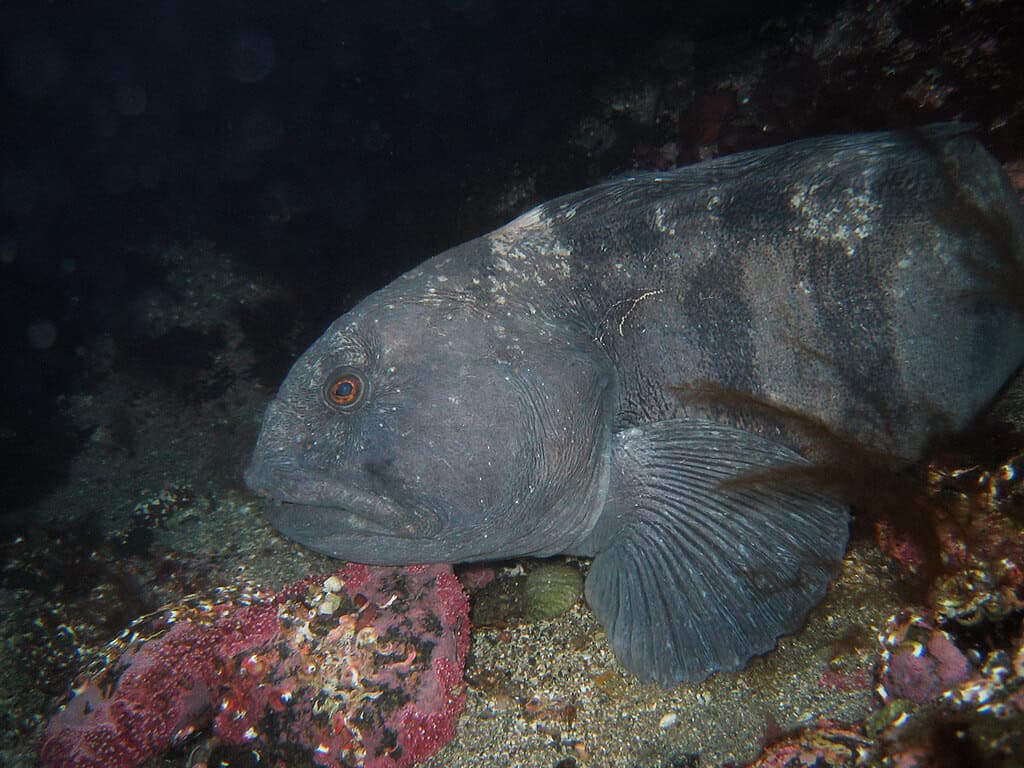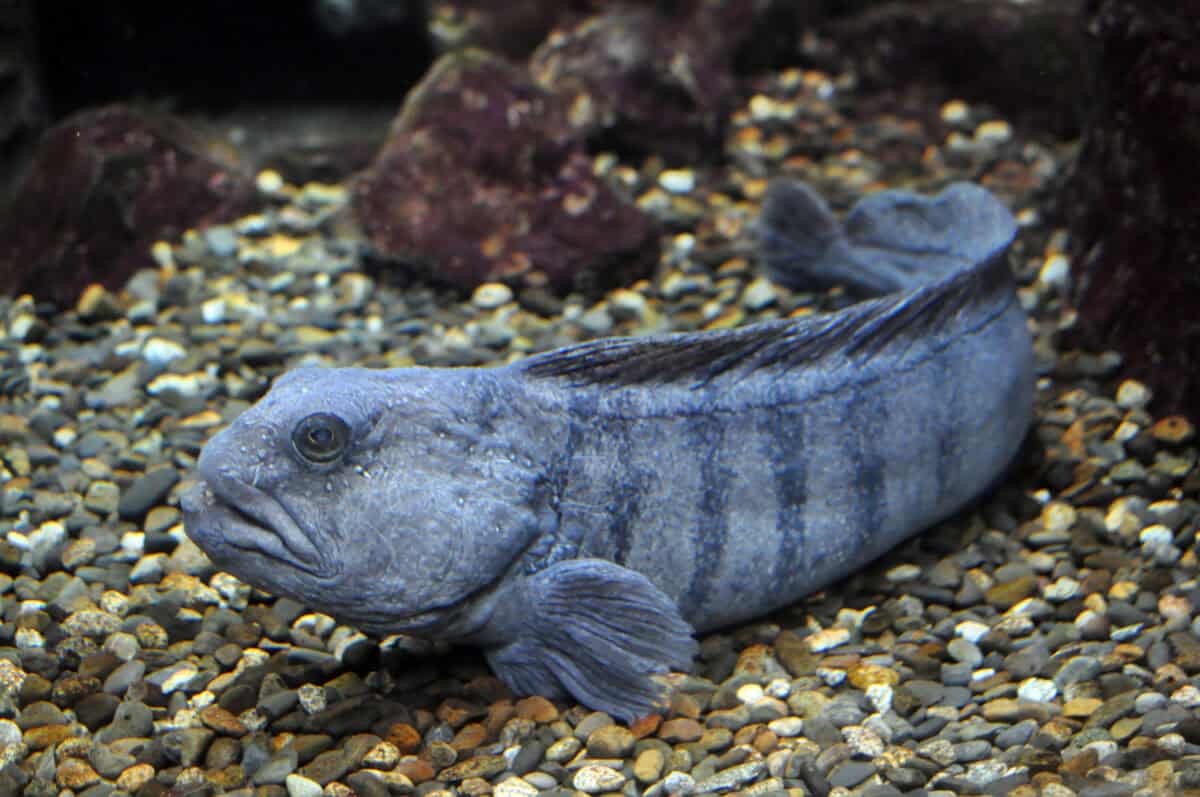In the depths of the ocean, nature often surprises us with creatures that defy our expectations. Among these remarkable animals is a fish that bears an uncanny resemblance to one of history’s most fearsome predators – the velociraptor. The Atlantic wolffish (Anarhichas lupus), with its elongated body, powerful jaws, and imposing teeth, has earned nicknames like “sea wolf” and “ocean raptor” due to its predatory appearance that evokes images of prehistoric hunters. This fascinating marine creature demonstrates how evolutionary adaptations can create similar forms across vastly different animal groups separated by millions of years and completely different environments.
The Atlantic Wolffish: Nature’s Marine Raptor

The Atlantic wolffish (Anarhichas lupus) is a large, bottom-dwelling fish that inhabits the cold waters of the North Atlantic Ocean. Growing up to 5 feet (1.5 meters) in length and weighing up to 40 pounds (18 kg), this formidable predator possesses physical characteristics that draw immediate comparisons to the velociraptor dinosaurs popularized in films and scientific literature. Their elongated body, powerful jaw structure, and especially their prominent, fang-like teeth create a striking silhouette that resembles the profile of these ancient reptilian hunters. While not actually related to dinosaurs in any way, the wolffish exemplifies how convergent evolution can produce similar predatory features in animals from completely different evolutionary lineages.
Fearsome Dentition: The Key to the Raptor-Like Appearance

The most raptor-like feature of the Atlantic wolffish is undoubtedly its remarkable set of teeth. The fish possesses three distinct types of teeth that serve different functions – sharp canine-like teeth at the front for seizing prey, followed by three rows of crushing teeth on the roof of its mouth, and strong molars at the back of its jaw. This specialized dentition allows the wolffish to crush hard-shelled prey like sea urchins, crabs, and mollusks with ease. When a wolffish opens its mouth, the arrangement of these teeth creates a visual reminiscent of the feared grin of a velociraptor, with prominent fangs and a mouth seemingly designed for tearing flesh. This dental structure, combined with its powerful jaw muscles, gives the wolffish its distinctively predatory and almost prehistoric appearance.
Evolutionary Convergence: Different Paths to Similar Forms

The resemblance between the Atlantic wolffish and velociraptors represents a fascinating case of evolutionary convergence – where unrelated species develop similar traits due to adapting to similar environmental pressures. Velociraptors evolved their predatory features for hunting on land in the late Cretaceous period, roughly 75-71 million years ago. In contrast, the wolffish lineage evolved its characteristics for hunting in cold ocean environments. Despite evolving along completely different evolutionary paths and being separated by millions of years, both creatures developed elongated bodies, powerful jaws, and impressive teeth as adaptations for their predatory lifestyles. This convergence illustrates how certain physical forms represent effective solutions to the challenges of being a predator, regardless of whether the hunting occurs on Cretaceous plains or in the depths of modern oceans.
Habitat and Behavior of the Ocean’s “Raptor”

Unlike the pack-hunting behavior often attributed to velociraptors, the Atlantic wolffish is primarily a solitary hunter that prefers the cold, rocky bottoms of the North Atlantic Ocean. They typically inhabit depths between 100 and 500 feet (30-150 meters), though they can be found at depths up to 1,600 feet (500 meters). These fish have adapted to life in frigid waters, with special proteins in their blood acting as a natural antifreeze that allows them to survive in temperatures near freezing. Rather than pursuing prey at high speeds like their dinosaur lookalikes, wolffish are ambush predators that use their powerful jaws and teeth to crush hard-shelled invertebrates. They are territorial and often inhabit the same rocky den for extended periods, venturing out primarily to feed and, during breeding season, to find a mate.
Diet: Crushing Prey Like Prehistoric Predators

The Atlantic wolffish’s diet further highlights its specialized predatory nature that parallels aspects of raptor feeding habits. Their primary food sources include sea urchins, crabs, large marine snails, clams, and other hard-shelled marine organisms that most fish species cannot consume. The wolffish’s extraordinary bite force allows it to easily crush shells that would deter other predators, making it a specialized hunter in its ecosystem. This specialization is similar to how velociraptors evolved specific adaptations for their hunting strategies. The wolffish’s ability to process tough, armored prey has earned it ecological significance as a population controller for species like sea urchins, which, if left unchecked, can decimate kelp forests and other important marine habitats. The specialized crushing ability, powered by strong jaw muscles, contributes significantly to its raptor-like appearance.
Physical Features Beyond the Teeth

While the distinctive teeth of the Atlantic wolffish are its most raptor-like feature, other physical characteristics also contribute to its prehistoric appearance. The fish possesses a large, somewhat flattened head with small eyes set high on the skull, giving it an alert, predatory appearance. Its body is elongated and muscular, tapering toward the tail, with a continuous dorsal fin running nearly the entire length of its back – creating a silhouette that could be compared to the streamlined profile of theropod dinosaurs. The wolffish’s skin lacks scales typical of most fish, instead featuring a thick, slimy mucus coating that protects it against parasites and infections. This smooth skin, often mottled with dark spots or stripes on a background ranging from olive green to purplish-brown, completes its unusual and somewhat primeval appearance.
Reproduction: A Contrast to Raptor Theories

Unlike what scientists believe about velociraptor reproduction, which likely involved laying eggs in nests as do most dinosaurs, the Atlantic wolffish’s reproductive strategy is quite different yet equally fascinating. These fish form monogamous pairs during breeding season – a relatively rare behavior among fish species. After mating, the female lays large eggs in masses on the ocean floor, often in crevices or among rocks. What makes their parental care particularly notable is that the male wolffish guards the egg masses for up to nine months, foregoing feeding to protect the developing offspring from predators. He also aerates the eggs by fanning them with his fins, ensuring they receive adequate oxygen. This level of parental investment contrasts with most bony fish species and represents an evolutionary strategy that helps ensure higher survival rates for their offspring in the challenging deep-water environment.
Conservation Status: An Endangered “Living Fossil”

Despite its fearsome appearance that invokes images of ancient predators, the Atlantic wolffish faces significant conservation challenges in the modern world. Currently listed as a species of concern in many regions, wolffish populations have declined dramatically due to commercial fishing (both targeted and as bycatch), habitat destruction from bottom trawling, and climate change affecting their cold-water habitats. In the United States, the Atlantic wolffish is considered a Species of Concern by the National Marine Fisheries Service, while in Canada, it has been designated as a threatened species. Conservation efforts are complicated by their slow growth rate, late maturity (around age 6), and relatively low reproductive output compared to many other fish species. Protecting this unique predator is crucial not only for preserving marine biodiversity but also for maintaining the health of North Atlantic benthic ecosystems where they play an important role in controlling populations of sea urchins and other invertebrates.
Cultural Significance and Human Perception

The raptor-like appearance of the Atlantic wolffish has influenced how humans perceive and interact with this species throughout history. In some fishing communities across the North Atlantic, particularly in Scandinavia and Iceland, the wolffish has been known by names translating to “sea wolf” or “sea cat” due to its fearsome teeth and predatory nature. Despite its intimidating appearance, the wolffish has been valued as a food fish for centuries, prized for its firm, white flesh that resembles lobster in flavor and texture. However, its frightening visage has also led to negative cultural perceptions, with some fishermen historically killing them as “monster fish” even when not targeting them for food. In modern times, the wolffish’s unique appearance has made it a subject of fascination in public aquariums, where it often becomes a centerpiece exhibit that draws attention to the diversity of ocean life and the conservation challenges facing unusual-looking species that may not initially evoke public sympathy despite their ecological importance.
Other Fish With Prehistoric Appearances

The Atlantic wolffish is not the only modern fish that bears resemblance to prehistoric creatures. The ocean harbors several species that seem like throwbacks to an earlier era in Earth’s history. The frilled shark (Chlamydoselachus anguineus), with its primitive-looking appearance and rows of trident-shaped teeth, has remained virtually unchanged for 80 million years. The coelacanth, once thought extinct for 65 million years until its rediscovery in 1938, represents one of the most famous “living fossils” with lobed fins that provide insight into the evolution of tetrapods. The alligator gar, with its armored scales and elongated, toothy snout, bears a striking resemblance to its namesake reptile. These examples, along with the wolffish, demonstrate how certain ancient body plans have remained effective through millions of years of evolution, allowing these remarkable animals to persist while countless other species have disappeared. The persistence of these prehistoric-looking fish highlights the remarkable resilience and adaptability of certain evolutionary designs.
The Science Behind the Resemblance

The visual similarities between the Atlantic wolffish and velociraptors offer an intriguing case study in comparative anatomy and evolutionary biology. Scientists note that both animals evolved as specialized predators, resulting in certain physical traits that serve similar functions despite evolving independently in completely different environments. The elongated body form, powerful jaw muscles, and prominent teeth represent adaptations for efficient predation. However, the resemblance is largely superficial; while velociraptors were fast-moving, warm-blooded reptiles with complex social behaviors, wolffish are cold-blooded, solitary fish adapted to stationary ambush hunting. The similarity in appearance represents what biologists call analogous structures—features that look alike and serve similar functions but evolved independently rather than from a common ancestral structure. This phenomenon differs from homologous structures, which have a shared evolutionary origin even if they now serve different functions. The raptor-like appearance of the wolffish thus represents a fascinating example of how evolution sometimes arrives at similar solutions to the challenges of predation across vastly different animal groups.
Conclusion: The Ocean’s Reminder of Prehistoric Predators

The Atlantic wolffish, with its remarkable resemblance to velociraptors, serves as a living reminder of how evolutionary pressures can create similar predatory forms across vastly different animal groups. Despite being separated by millions of years and completely different environments, both creatures evolved specialized hunting adaptations that resulted in certain visual similarities, particularly in their fearsome dentition and powerful jaws. As climate change and overfishing threaten wolffish populations, conservation efforts become increasingly important to ensure this unique marine “raptor” continues to fulfill its ecological role in North Atlantic ecosystems. The wolffish’s story invites us to look beyond its intimidating appearance to appreciate a remarkable creature that has perfected its predatory niche through millions of years of evolution, demonstrating nature’s capacity to develop effective solutions to survival challenges across diverse animal lineages.
- Why Nurse Sharks Are Often Misunderstood - August 9, 2025
- 9 Most Venomous Spiders Lurking in US Homes - August 9, 2025
- How Scientists Tag and Track Sharks Off Florida’s Coast - August 9, 2025

